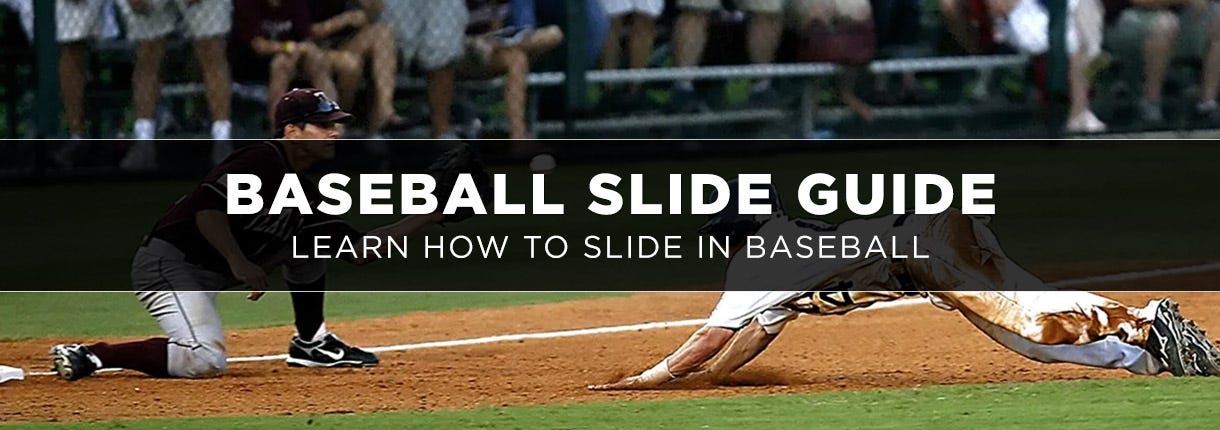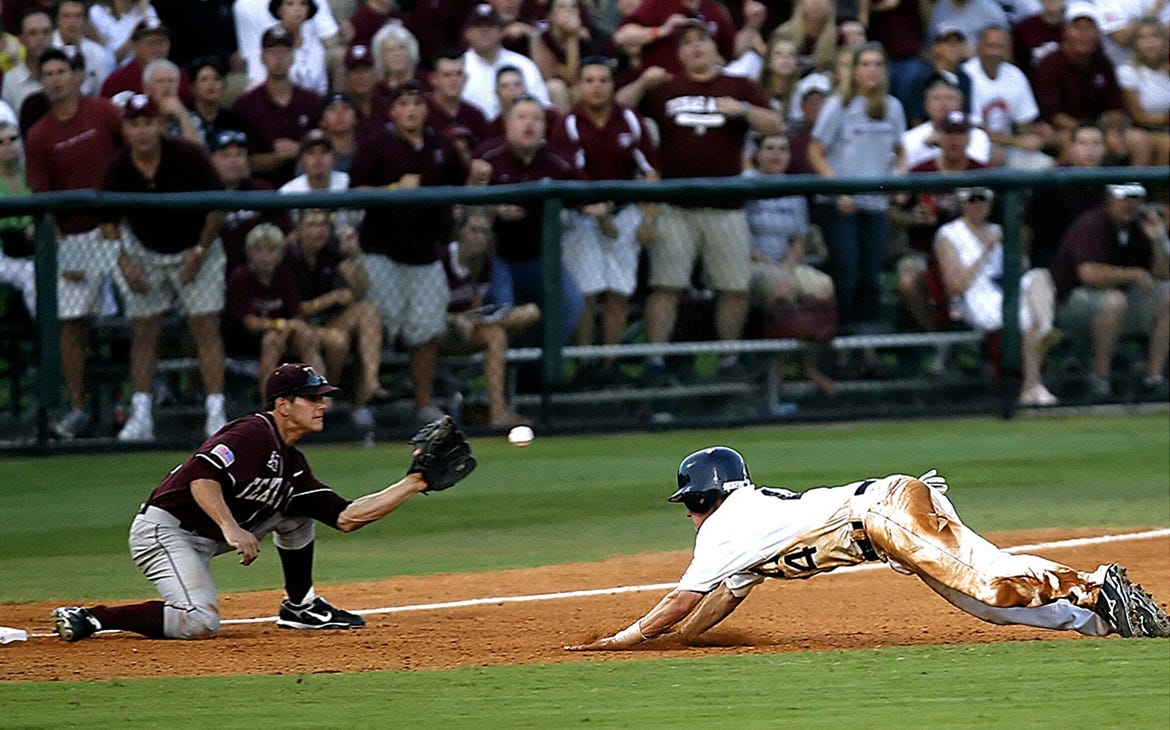Baseball Slide Guide: Learn How to Slide in Baseball


Running the bases is one of the most exciting things you can do on a baseball field, and sliding is not only equally thrilling, but also an important skill for any base runner to master.
In this article, we’ll discuss how to slide correctly and safely, what different types of slides look like, the rules for sliding, drills to help you slide better and why sliding is important. Keep reading to learn everything there is to know about sliding in baseball, including:
- How to Slide in Baseball (Bent-leg)
- Types of Baseball Slides
- Baseball Sliding Rules
- Baseball Sliding Drills
- Common Questions About Sliding
The main goal of sliding is to allow a runner to make it to the base before being tagged out in the event of a close play (sometimes called a “bang-bang” play). Sliding makes you a more difficult target for the defender covering the base, who has to catch the throw and then try to tag you before you touch the base. If done correctly, sliding can help you steal bases, advance an extra base when your batter gets a hit and ultimately, score more runs.
How to Slide in Baseball (Bent-leg)
Learning to slide starts with becoming comfortable with throwing yourself on the ground at full running speed. For now, we’ll focus on a feet-first slide, which is most commonly used type of slide. Before attempting a full-speed slide, you should become familiar with the various aspects of sliding.
Learn the Sliding Form (Bent-leg)
The most common sliding form involves leading with your dominant foot, leg stretched straight, and bending your non-dominant leg so the foot is tucked behind the dominant knee. The part of your body that’s actually sliding on the ground should be the thigh and shin of your non-dominant leg.
Keep Your Hands Up and Chin Tucked
When in your sliding position, lift your hands up past your head with your arms stretched away from your body. This will stabilize your body as it’s sliding and it also prevents the defender from easily tagging your hand with his or her glove. Tuck your chin toward your chest so your head doesn’t flop backward and hit the ground.
Sit in Sliding Position for Several Minutes
Before even attempting a slow motion slide, get yourself familiar with the proper sliding form by sitting on the ground in the sliding position for several minutes. Don’t forget to raise your hands and tuck your chin.
'Walkthrough’ Sliding Practice
The first couple practice slides you try should be done at a walking or jogging speed. At a low speed, you won’t actually slide on the ground, but these practices will help you figure out how far from the base you need to drop into sliding position. You should start your slide when the distance between you and the base is roughly your body length. Though this isn’t an exact science, it’s important not to slide too soon or too late, or you‘ll either slide past the base or not reach it at all.
Practice on a Mat
Before you try sliding on the dirt basepath, you should use a soft mat or a grassy surface, as these practices are more about getting you mentally prepared. Take your time working your way up from walking through your slide to jogging to, eventually, running.
Practice on the Dirt
The last phase of your practice should be on a dirt basepath, and your goal at this point is to make sliding feel as natural as possible. Practice making contact with the base you’re sliding into with your toe and keeping some part of your body touching the base at all times. If at any point you’re not touching the base, the defender can tag you out.
Types of Baseball Slides
Now we’ll take a look at the different types of slides you can learn on your way to becoming a master base runner. The bent-leg (or feet-first) is the most important slide to learn because it’s the most common form of slide, and it’s also the safest way to slide. If you’re new to the game of baseball, the bent-leg slide is the ONLY slide you should attempt - the others listed here should be regarded as strictly informational tools for now.
- Bent-leg Slide (Feet First). Lead with your dominant foot, toes pointed forward and leg straightened, and your non-dominant leg bent at the knee. Your non-dominant foot should be tucked under the opposite knee, creating the shape of the number four with your lower half.
- Pop-up Slide. Use the same form as the bent-leg slide, but flatten your foot so its side is parallel to the ground. Next, aim your foot for the broad side of the base and use your momentum to pop up into a standing position when you make contact with the base.
- Head First Slide. Throw your hands ahead of your body and dive to the ground as if you’re diving into a pool, keeping your legs straight behind you and your chin lifted away from the ground. You should only attempt this slide if you’re absolutely comfortable doing so. Even for advanced base runners, this can be a dangerous slide.
- Hook Slide. The hook slide has the same form as the bent-leg slide, only the non-dominant foot is pointed outward instead of tucked underneath the other knee. You should aim your dominant foot away from the base and try to touch the base with your other foot in order to keep your body away from the defender.
- Backdoor Slide. Start by doing exactly what you would for a bent-leg slide, but this time, slide away from the base altogether. When your shoulders become even with the base, rotate your body and reach for the base with a hand. This slide should be used if the throw reaches the defender before you reach the base, as you'll be sliding away from the defender, causing him or her to have to reach for you.
- Hands First Slide at Home. When sliding head-first at home plate, you won’t be able to slide straight through it, as the catcher will be blocking it with his or her body. You have to commit to sliding on one side of the plate or the other, and reach for it with your hand as you pass the catcher. Remember, you only have to touch home plate once, whereas you must maintain contact on first, second and third bases.
- Take Out Slide. Take out slides can only be attempted at second base and it is done with the sole intent of breaking up a double play. When sliding, you should aim your body directly in front of the defender, forcing him or her to move out of your way, altering their throwing motion.
Baseball Sliding Rules
Major League Baseball (MLB) has created rules for sliding that players must follow under penalty of an automatic “out” being called. The rules are designed for both the defender and runner’s safety and should therefore be followed at all levels of the game, professional or not.
Baseball’s ‘Slide Rule’
When attempting a take out slide, the base runner cannot initiate contact with the defender, meaning the runner has to attempt a real slide. However, the runner can direct the slide at the defender as previously discussed. If the runner throws his or her shoulder at the defender, lifts their leg or grabs the defender by hand, the runner and the hitter will be called “out.” Umpires won’t penalize runners for accidental contact if the runner attempts a valid slide.
Sliding into Home (and the ‘Buster Posey Rule’)
On May 25, 2011, Florida Marlins base runner Scott Cousins tackled San Francisco Giants catcher Buster Posey when trying to score from third base. Cousins ran slightly inside the baseline and purposefully rammed himself into Posey right as the throw arrived. Posey suffered a broken leg as a result, and MLB responded by implementing a home plate collision rule. The rule prohibits base runners from leaving the base path to initiate contact with a catcher. It’s worth noting that some semi-pro and amateur leagues (especially youth leagues) have outright banned home plate collisions.
Sliding into Second Base
A runner sliding into second base must attempt a true, valid slide when trying to break up a double play or avoid a tag. Initiating contact with a defender is strictly prohibited and will result in the runner being called “out.”
Sliding into First Base
When sliding into first base, the runner must stay in the baseline. Since runners can run through first base (as long as they don’t make a move toward second base), the only time a runner should slide into first base is if it’s obvious ahead of time that the throw is going to be high.
Baseball Sliding Drills
- Pickle. The pickle drill is meant to simulate a rundown situation, when a runner is caught between two bases. The runner should try to get to second base or return safely to first without being tagged out, while the infielders and pitcher chase him or her down.
- Drill 2. Have a coach, parent or teammate stand on second base while you run toward them. As you approach, they should raise their hand to simulate getting ready to catch a throw - this will help you get a feel for when you should start your slide.
- Drill 3. Set up the same way, only have the person standing on the base randomly shout types of slides for you to execute as you approach the base.
Common Questions About Sliding in Baseball
Can the catcher block the plate in MLB?
MLB allows for the catcher to block the plate if he or she has the ball or is about to receive the ball. Rules may vary at different pro and amateur levels, but blocking the plate is a technique catchers have to learn to make it difficult for runners to score.
Is jumping over the catcher legal?
Jumping over the catcher is legal under MLB’s rules, as long as the runner doesn’t initiate contact with the catcher by leaving the basepath. However, to prevent concussions and other injuries, it’s unwise to attempt this at any level.
What is the baseline rule in baseball?
The baseline rule states that base runners must remain in the baseline when running the bases, which is generally defined as a straight line from base to base. Runners may deviate from the baseline only when passing one base to run toward the next.
What is the obstruction rule in baseball?
The obstruction rule prevents a defender from blocking a base without the ball, or without the possibility of getting the ball before the runner arrives. Offenders will be called for obstruction of the basepath. The umpire may award the runner any base he or she sees reasonably fit.
Executing a perfect slide can be the winning ticket in a game. Learning how to slide effectively and safely is an important aspect for any player attempting to hone their game.








